With so many different types of guitar strings available, it can be hard to know which ones are right for you. Do you buy flat wound or round wound? Round core or hex core? And what’s the difference between nickel-plated and pure nickel?!
It can be a bit overwhelming if you don’t know what you’re looking for. I’ve been through hundreds of sets of strings over the years, and have written this guide to share my knowledge with you on what guitar strings are made of, and how this affects you guitars tone and feel.
Affiliate disclaimer: This page contains affiliate links for products that I’ve tried and tested. As an Amazon Associate I earn from qualifying purchases at no additional cost to you. Learn more here.
Understanding the parts of a guitar string
Before we get into the different materials that make up a guitar string, let’s start with a quick look at the differences between wound and plain strings, and then looking at the different parts of a guitar string.
Wound vs plain strings
Take a look at any pack of electric guitar strings and you’ll see that the lower pitched strings are different from the higher pitched strings. When you run your finger along them, you’ll feel that the lower strings have bumpy ridges, whereas the higher strings are smooth. This is because the lower strings are wound and the higher strings are plain.
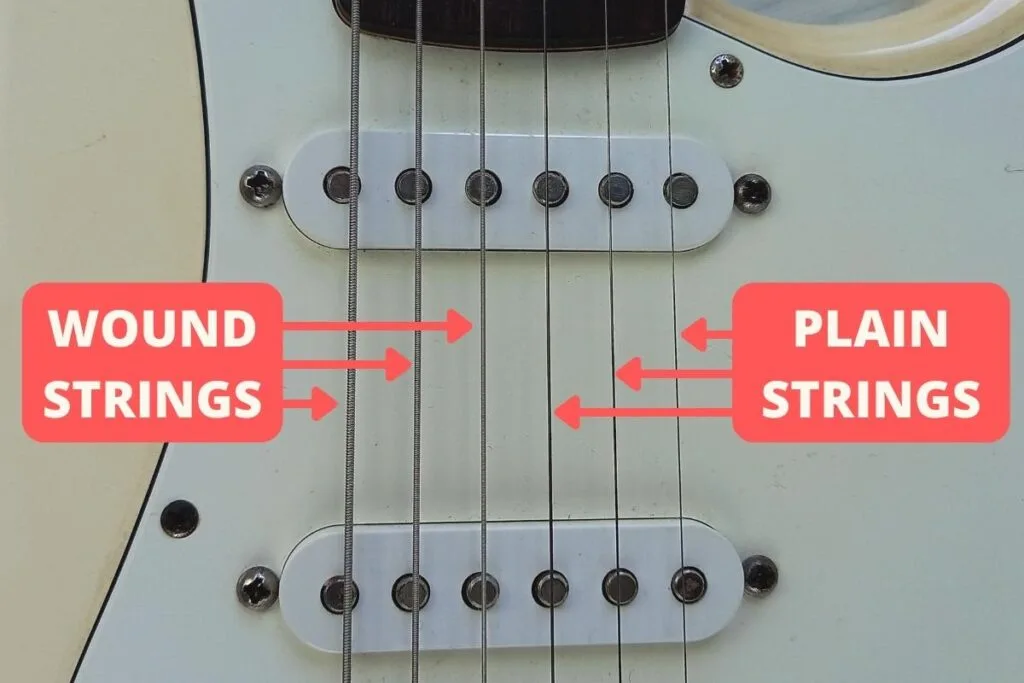
Wound guitar strings have an outer wire that’s wrapped around a core wire. This makes the string thicker, while still being flexible and able to vibrate. If the thicker strings were just made out of a single, thick wire, then they would be way too thick to vibrate and would be completely unusable.
A good way to picture it is to imagine a string made out of the same material as a paperclip. You can imagine how hard it would be to play, and how bad it would sound!
Guitar string manufacturers use different materials for the windings to get different sounds, but more on that later.
Plain guitar strings, on the other hand, are just a single piece of string. So, they don’t have a core wire, as they’re much thinner and can naturally vibrate and bend. These strings are always made from some type of steel alloy, no matter what.
String winding
For electric and acoustic guitars, it’s usually the bottom three strings are wound (E, A, and D). Sometimes, you might have a wound G string too, but more on that shortly. The remaining strings are plain.
On a bass guitar, all the strings are wound, as they need to be very thick to reach the lower pitched notes.
There are three types of wound string for guitar: round wound, flat wound, and half wound.
| Round wound | Flat wound | Half wound | |
|---|---|---|---|
| Sound | Brighter | Mellower | In-between round and flat |
| Longevity | Shortest | Longest | In-between round and flat |
| Cost | $ | $$$ | $$ |
| Best for | Any genre | Jazz and blues | Vintage guitar tones |
Round wound
These guitar strings are the most common type of guitar string available. They get their name from the round, circular shape of the wire that wraps around the core.
They produce a brighter sound compared to other string winding types, with a lot of rich harmonics. I find them to be very versatile, and great for playing any style of music. They’re especially useful for when I need to drop tune my guitar, as they retain their crisp, bright sound without becoming muddy sounding.
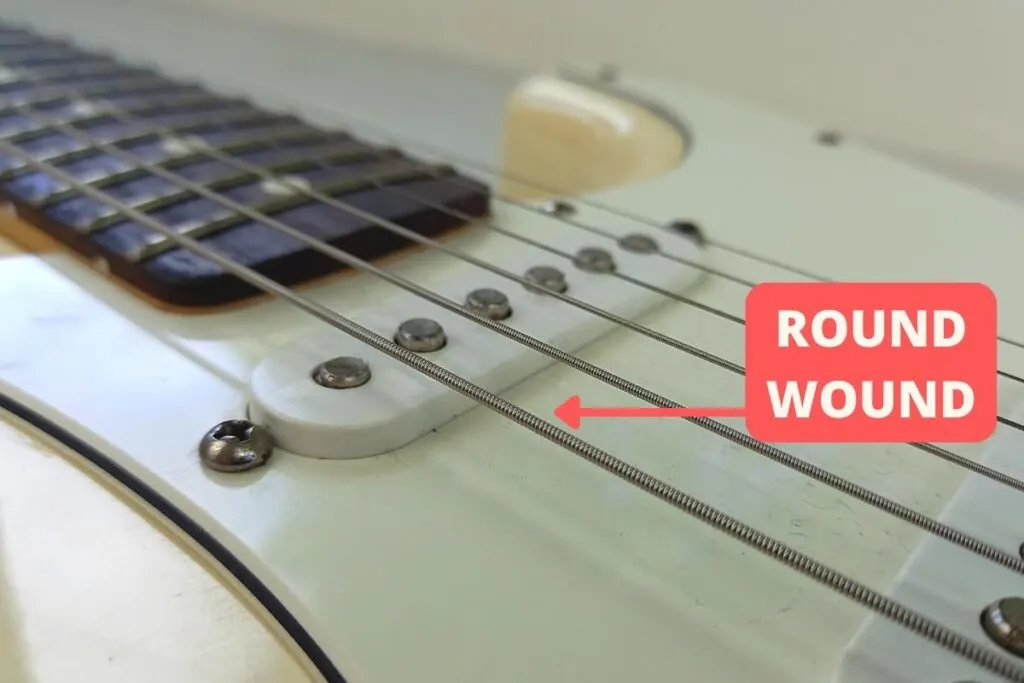
As they’re more common, they’re much cheaper than other string winding types, which is an added bonus!
They are, however, more likely to get dirty and break than other string types. Dirt can get between the ridges which can make the strings less flexible and more likely to break over time. Likewise, the built up grime will make your strings sound flatter and less musical over time.
Fortunately, a quick clean of your guitar strings after playing will slow this process down, keeping them fresher for longer.
Flat wound
Flat wound strings use a flat wire to wrap around the core. This gives the string a much mellower, warmer tone that’s perfect for jazz. In fact, a lot of the guitar string manufacturers market these flat wound strings as “jazz” strings.
The fact that the string winding is flatter also means that there’s less ridges, making the string feel smoother. This is beneficial as it means that there’s less chance of dirt collecting in the strings and aging them. It also means that there’s less of that annoying string squeaking, called “finger noise”, as you move across the fretboard.
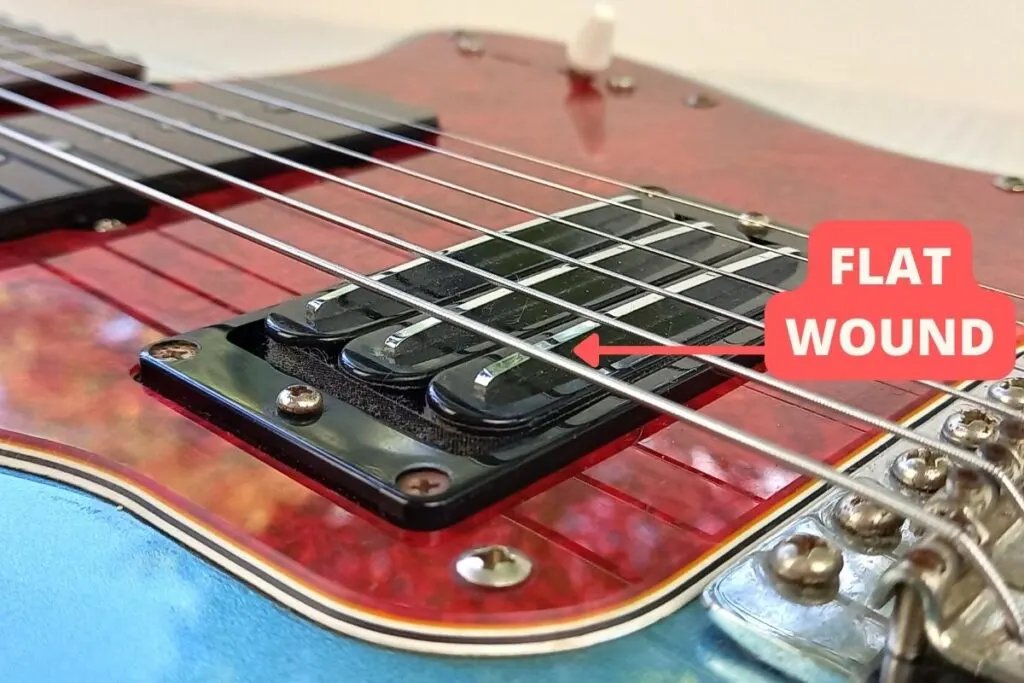
I find that, in some cases, this type of string can sound a bit too mellow and can begin sounding muddy when playing power chords lower down the fretboard. They’re also much more expensive than round wound strings. I’ve found them to be at least two or three times the price of round wound strings!
For these reasons, they may not be for everyone. But, I do recommend picking up a set and trying them for yourself at least once. I have a set of Olympia flat wound strings (10-46) on my Fender Marauder. These aren’t readily available worldwide, so I’d recommend checking out flat wound strings on Amazon! Brands like GHS, D’Addario, and DR Strings are all safe bets.
Half wound
Half wounds, sometimes called “ground wound” or “semi-flat wounds”, are a round wound string that has been lightly filed down to be flatter. As you might guess, it makes it somewhere between a round and flat wound string, kind of a “best-of-both” solution.
As such, they share a lot of the same characteristics as both types of string. They sound bright, but have a mellowness to them. They’re crisp on the attack, but have a warm sustain. The filed down windings also means that you also get less finger noise.
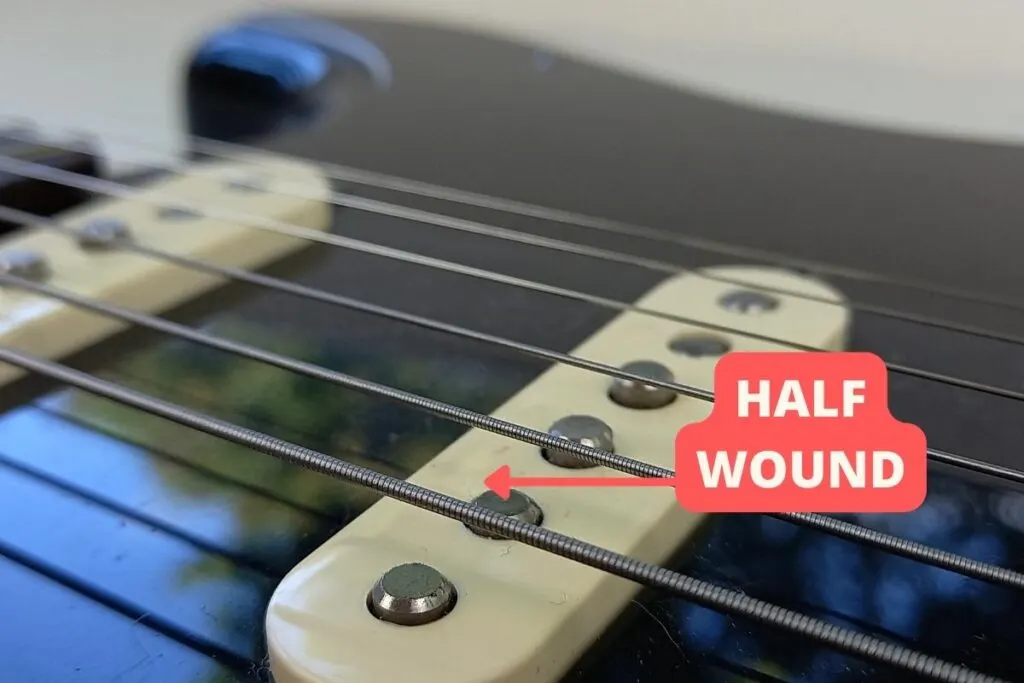
These strings are still slightly more expensive than round wound strings, but less so than flat wounds.
These strings will give you a warm, vintage guitar tone that’s great for rock, blues, and metal (think early Black Sabbath!).
Like flat wound strings, though, I find that these strings are best when you have a specific need for them. But, I also recommend trying them for yourself. I use D’Addario XL Half Rounds (10-46) on my Fender Stratocaster. Check them out here on Amazon, and give them the next time you change your strings.
Plain strings
Now we come to the plain strings. Remember, these strings don’t have a core or any winding, they’re just a solid, plain string.
These strings are most often the top three strings: high e, B, and G. I say “most often” as some guitar string packs have a wound G string. This is shown clearly on most guitar string packs. If you see a “p” next to the string it means it’s plain, if you see a “w” it’ll be wound.
These thinner strings don’t need any winding as they’re thin enough to be tuned to pitch while still being able to vibrate and produce the proper harmonics, and be bent.
Question: What type of guitar strings do you use, and why? Let me know in the comments below!
String core
String cores form the center of wound guitar strings, and are made of a steel alloy. The exact make up of the alloy varies across different guitar string brands, but they’re all steel based.
There are two types of guitar string cores: hex core and round core. These two cores have a different shape that affects the sound, feel, and price of your strings.
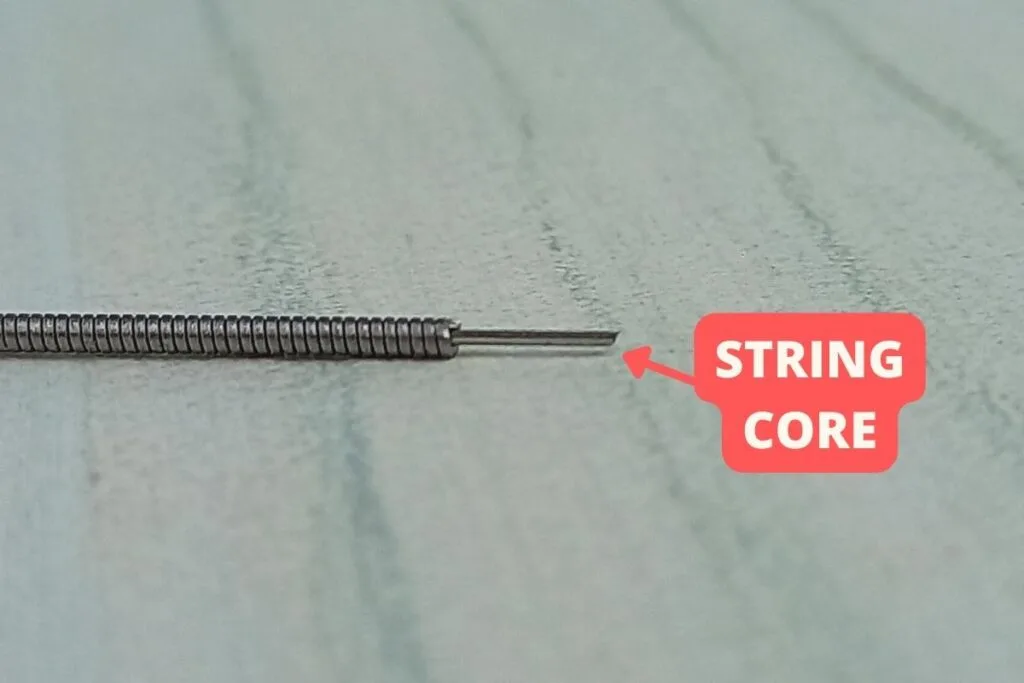
| Hex core | Round core | |
|---|---|---|
| Sound | Brighter | Mellower |
| Cost | $ | $$ |
| Best for | Modern styles of playing | A vintage guitar tone |
Hex core
This type of string has a core wire with a hexagonal cross-section. The hex core was pioneered by D’Addario, and is the most common type of core used in guitar strings today.
The wound wire comes into contact with the six corners of the hexagon, which helps them to keep their tuning better compared to round core strings.
Tonally, these strings sound brighter than round core strings. Their tight high end makes them essential for maintaining clarity when using lower pitched tunings.
They also have a slightly higher “attack”, meaning that the notes sound crisper and clearer when plucked or strummed.
As they’re more commonly available, they’re cheaper than round core strings, which will cost you a few dollars more.
A potential downside to these, however, is that hex wound strings have a slightly higher string tension than round core strings of a similar string gauge. This means that they’re slightly tougher on your hands, and harder to bend. That being said, it’s a very minor difference!
Round core
Round core strings are the oldest type of string core design. These strings have a circular shaped core, so the string winding sits completely flush against the core.
The string winding sits completely against the core, so they are both in full contact
As this type of core design is older, it’s very much associated with a vintage sound. These strings produce fewer higher frequencies which gives them a richer, warmer sound than hex core strings.This makes them perfect for jazz and vintage rock and blues.
Round core strings generally have a lower string tension than another of the same string gauge meaning that they’re a bit easier to bend and fret.
As I mentioned, they’re slightly more expensive than hex core strings, but only by a few dollars. So, as long as you’re not restringing your guitar every few days, this shouldn’t be too much of a problem.
You do need to be careful when fitting these strings, however, as the winding can come loose if they’re not properly installed. It’s simple enough to do, here’s a guide from DR Strings.
Ball ends
Ball ends are the part of guitar string that anchors the string to the bridge.
In most guitar packs, the ball ends will have different colors. The pack will tell you which colors are which string, which makes it easier to string your guitar.
Most strings have the same donut-shaped ball end design. Some strings, like the fender bullet strings, have an elongated ball end shaped like a cylinder. Fender claims that this improves the tuning stability and sustain. Personally, I’ve never noticed much of a difference!
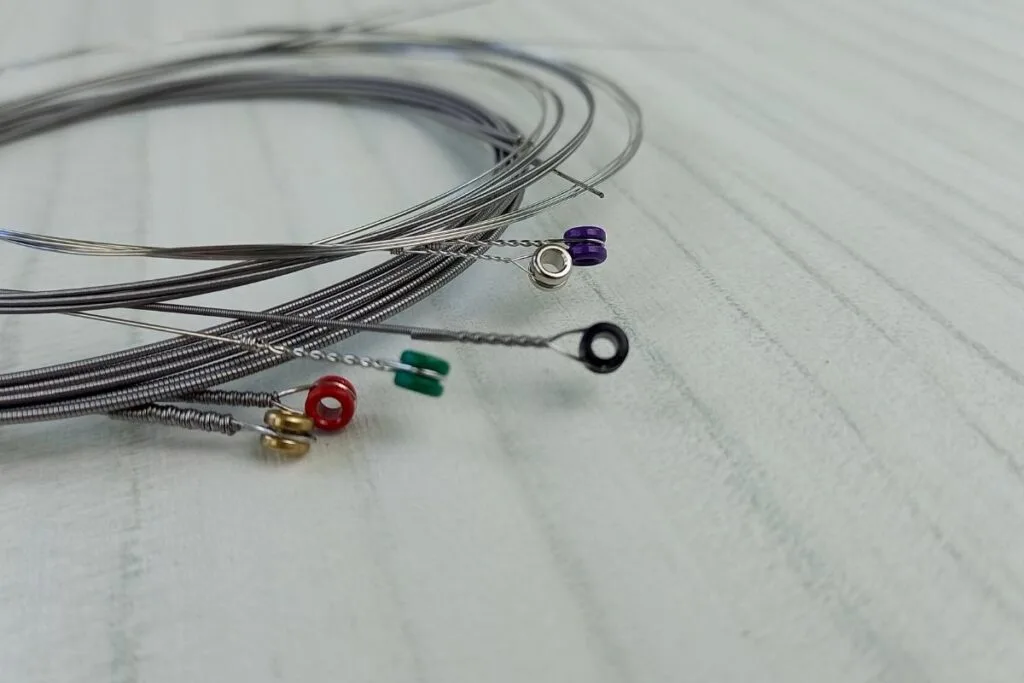
Coated strings
Before we move on to what guitar strings are made of, the final part of a strings design is whether or no it’s coated.
Coated guitar strings are covered with a fine polymer layer, usually Teflon. This layer protects the metal string from dirt, sweat, and grime that would otherwise get into the windings and damage the string. So, this means that the strings stay cleaner and last longer compared with uncoated strings.
Most guitar strings, however, are uncoated. As it’s the most available type, and has less manufacturing overheads, uncoated strings tend to be cheaper.
If you’re someone who doesn’t want to change their strings too often, then coated strings might be the way to go!
Materials used to make guitar strings
As I said earlier, guitar strings come in packs that have both wound and plain strings, except for bass strings, which are all wound.
The plain strings are all made from a steel alloy which is the same material as the cores of the wound strings. So, on any guitar string pack, the plain strings will always be a steel alloy. The exact mixture of the alloy varies across the different manufacturers, but they’re all some type of steel alloy.
The biggest difference across strings is the material used on the wound strings. So, whenever you see a string set referring to a specific material, like “nickel” or “steel”, it means the material of the wire wrapping used on the wound strings.
Electric guitar and bass strings
Electric guitar and bass strings have the widest variety of string materials across the different guitar types. That being said, the most common are nickel-played, pure nickel, and stainless steel.
| Nickel-plated | Pure nickel | Stainless steel | |
|---|---|---|---|
| Sound | Bright | Warmest | Brightest |
| Longevity | Shortest | In-between nickel-plated and stainless steel | Longest |
| Cost | $ | $$ | $ |
| Best for | All rounder | Vintage guitar tones | All rounder / Alternative to Nickel strings |
Nickel-plated
This is the most commonly used type of wire for winding guitar strings. Nickel-plated wire is a steel wire that has been coated in a layer of nickel. Typically, they’re called “nickel wound” strings. If you’ve ever bought nickel strings before, they were most likely nickel-plated.
These strings sound bright with a quick attack that gives them a crisp sound. They also have a high output compared with other types of strings. They’re also often the cheapest type of string available
But, because they’re only nickel plated, their sound changes over time as the nickel layer wears away from the wire wrap, leaving the stainless steel exposed. This is one factor that leads to their sound changing over time.
Nickel-plated strings are the standard on most guitars. They’re a solid all rounder for any genre, and are my recommended string of choice.
Pure nickel
As the name suggests, pure nickel strings use a wire wrap that’s 100% nickel on the wound strings. This gives the string a mellower tone that’s much warmer than nickel-plated strings. They were commonly used on guitar’s in the 1950’s, which gives them an authentic “vintage” tone.
These strings will often cost you a few extra dollars compared to nickel-plated strings, and they’re also stiffer, which means that they’ll feel harder on your hands.
That being said, these strings generally last longer tonally, meaning that you don’t get a drastic of a tonal roll-off than with worn nickel-plated strings.
Like flat wound strings, pure-nickel strings are best used if you have a specific need for them, like if you’re looking for a rich, vintage guitar tone.
Stainless Steel
For this type of string, stainless steel wire is wrapped around the core wire.
Stainless steel is a very durable and hardy material compared to the other types of strings we’ve looked at so far. This means that they’re less susceptible to corrosion and rust, which gives them a longer lifespan.
However, it also means that they wear harder against your guitar frets, which can cause them to wear down faster over time.
These strings have a strong output and bright sound – brighter than nickel-plated strings. They’re also a great practical alternative for guitarists that are allergic to nickel, at a similar price.
Other alloys
While nickel-plated, pure nickel, and stainless steel strings are the most common types of guitar strings, there are other types available.
Materials such as cobalt, chrome, monel, and even gold are used to make more niche guitar strings.
As they’re less common, they’re more expensive than the other more available strings.
Personally, I’ve not used these types of strings before, as I’ve never had a reason to! But, they’d make a great alternative if you have a nickel allergy, or just want to try something out of the ordinary!
Acoustic guitar strings
Acoustic guitar strings have less of a variety of wound strings available. The market is primarily dominated by phosphor bronze and 80/20 bronze strings.
| 80/20 bronze | Phosphor bronze | |
|---|---|---|
| Sound | Bright and bassy | Mellow, balanced, more natural |
| Longevity | Shorter | Longer |
| Cost | $ | $ |
| Best for | All rounder, more modern sounding | All rounder, but great for folk |
80/20 bronze
This string gets its name from the ratios used to make the metal alloy: 80% copper and 20% zinc. Along with phosphor bronze, it’s one of the most commonly available types of acoustic guitar strings available. Though, it’s less popular nowadays than it used to be.
They have a bright sound, but they’re not lacking in bass either. This gives you a strong, “in-your-face” sound that’s great for modern acoustic styles of playing, like country rock. They’re also very affordable.
Unfortunately though, these strings do age quicker than phosphor bronze. Over time, they can become dull, dry, and wooly sounding. If you’ve ever picked up an old acoustic guitar and given it a strum, you’ll know exactly what I mean!
In fact, my acoustic guitar is already showing signs of string damage after just 2 months of light use, which you can see in the below picture.
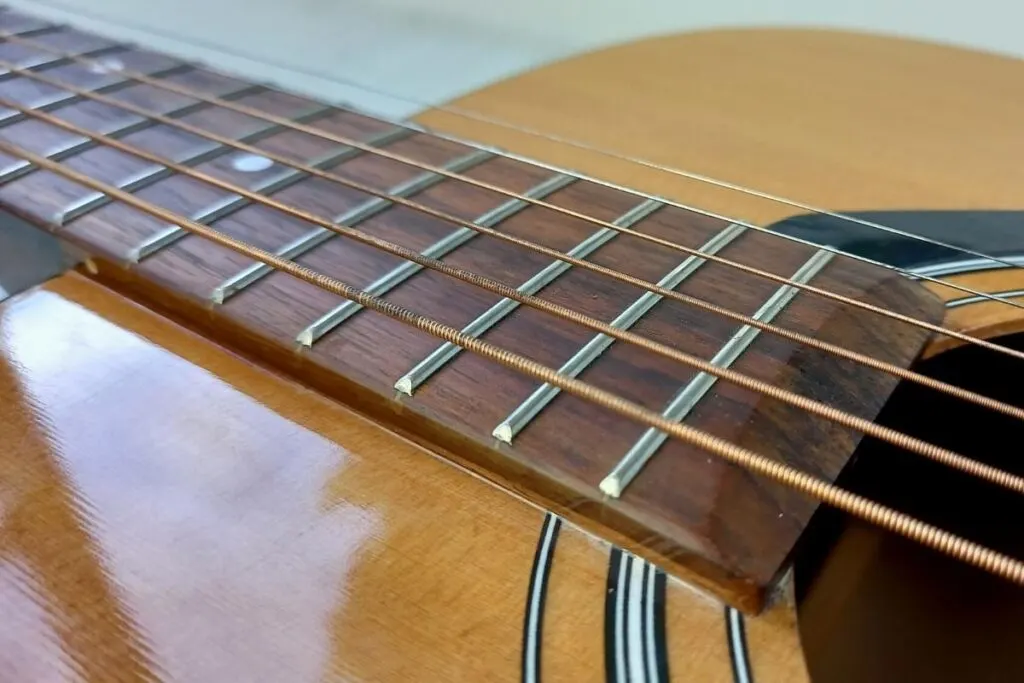
Still, these are great all rounder strings that will give you a bright, full sound.
Phosphor bronze
Phosphor bronze is the most common and popular string materials for wound acoustic guitar strings. It was originally developed as a solution to the aging problems of 80/20 strings.
The phosphor (which makes up less the 1% of the alloy) slows down the tarnishing process, giving the strings more life.
The change in materials also gives the strings a slightly different sound. These strings have a much more even response than 80/20 strings. Their mellower, warmer tone makes for a more natural sound that I think works great for folk music.
Other alloys
Phosphor bronze and 80/20 bronze make up the lions share of the acoustic guitar string market. But, other strings like stainless steel and nickel plated strings are available.
They have the same tonal qualities as their electric string counterparts, and are generally harder to use than the bronze alloys.
If you’re just learning acoustic guitar, and don’t have a specific need for strings with alternative alloys, I recommend using either of the bronze strings types. Personally, I’d recommend phosphor bronze, due to the longer lifespan. You can check out a set here on Amazon.
Summary
The guitar strings you use have a lot to do with the tone and playability of your guitar, so it’s important to choose the right ones for you!
For most guitarists, a hex core string that’s round wound using nickel-plated steel is perfectly fine to use. In fact, it’s the most common type of string there is. The chances are high that your guitar is strung with them right now!
If you’re looking for a more mellow, vintage tone, then you’ll want to try a round core string that’s either flat wound or half wound with pure-nickel.
For our acoustic friends, 80/20 bronze will give your guitar a lot of power, whereas phosphor bronze strings will give you a mellower, warmer sound.
We live in a time when there’s such a variety of different guitar strings! Why don’t you try something new the next time you restring your guitar?
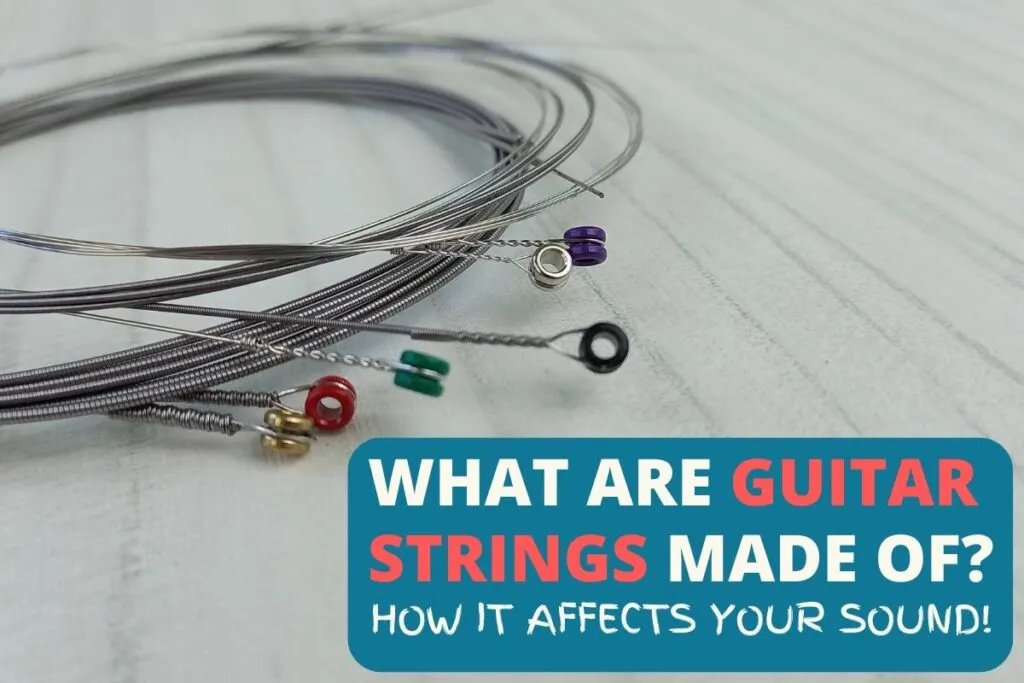

Conor is a music producer, multi-instrumentalist, and all-round enthusiast from the UK with over 15 years of experience. He’s the founder and sole-content creator for the roundtable audio blog and YouTube channel.
